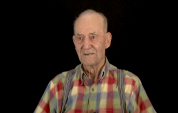5:02 | The engineer battalion boarded a rickety Liberty ship that was commanded by a retired Merchant Marine captain who had been summoned back to service. This old salt really hated the Navy. Fortunately, they had escort, which came in handy when a Japanese sub appeared. (This interview made possible with the support of RICHARD G. MCDANOLDS.)
Keywords : David Strickler Liberty Ship Marshall Islands Merchant Marine submarine (sub) sub chaser depth charges KA (Cargo Attack) Japanese

His experience in construction work determined his path in the Marines. David Strickler started running a crane when he was fourteen years old and he could operate most any heavy machinery. He joined a newly formed engineer battalion and shipped out for the Pacific. (This interview made possible with the support of RICHARD G. MCDANOLDS.)
Combat engineer David Strickler went into Guadalcanal with the Marines after dodging Japanese air attacks offshore. He describes the planes coming in and a near miss from a dive bomber. (This interview made possible with the support of RICHARD G. MCDANOLDS.)
While on Guadalcanal, David Strickler had to contend with a lone Japanese plane that would come over in the middle of the night and attack the Marine bivouacs. One night while investigating the damage, he made a grisly discovery. (This interview made possible with the support of RICHARD G. MCDANOLDS.)
While constructing a runway on Guadalcanal, combat engineer David Strickler had to dodge rounds from a Japanese artillery piece mounted on rails. It would emerge from a cave up in the high ground and rain shells down below. (This interview made possible with the support of RICHARD G. MCDANOLDS.)
After Guadalcanal was secured, combat engineer David Strickland and his unit were sent to New Zealand to recuperate and refurbish their equipment. He suffered a sprained ankle while working on a bulldozer but at least he avoided the malaria that hit so many others. (This interview made possible with the support of RICHARD G. MCDANOLDS.)
As combat engineer Davis Strickler watched Navy personnel drop and ruin a crane they were unloading, he knew he had to step in and show these guys how it's done. The Navy officers were suitably impressed. This was at Tinian, which was also where a buddy of his showed up with a jug of sake. Was it safe to drink? (This interview made possible with the support of RICHARD G. MCDANOLDS.)
David Strickler recalls a big storm he rode out when his engineering unit was being transported from Tinian to Okinawa. Once there, he had to contend with mud and snipers. He also saw a spectacular kamikaze attack in the harbor. (This interview made possible with the support of RICHARD G. MCDANOLDS.)
The rumor was that they were going to China. This didn't sit well with David Strickler and the others in the engineering outfit who were on Okinawa. Somehow, he and some buddies managed to get to Tinian and get papers for home. (This interview made possible with the support of RICHARD G. MCDANOLDS.)
After his time in the Pacific theater, Marine David Strickler was posted to the Naval Air Station at St. Simons Island, where he was in charge of the base police. He returned to his construction roots when he was transferred to Quantico and finished his time in the Marines managing projects there. (This interview made possible with the support of RICHARD G. MCDANOLDS.)
Marine combat engineer David Strickler remembers several incidents related to that time honored tradition for servicemen, trying to find a good, stiff drink. (This interview made possible with the support of RICHARD G. MCDANOLDS.)